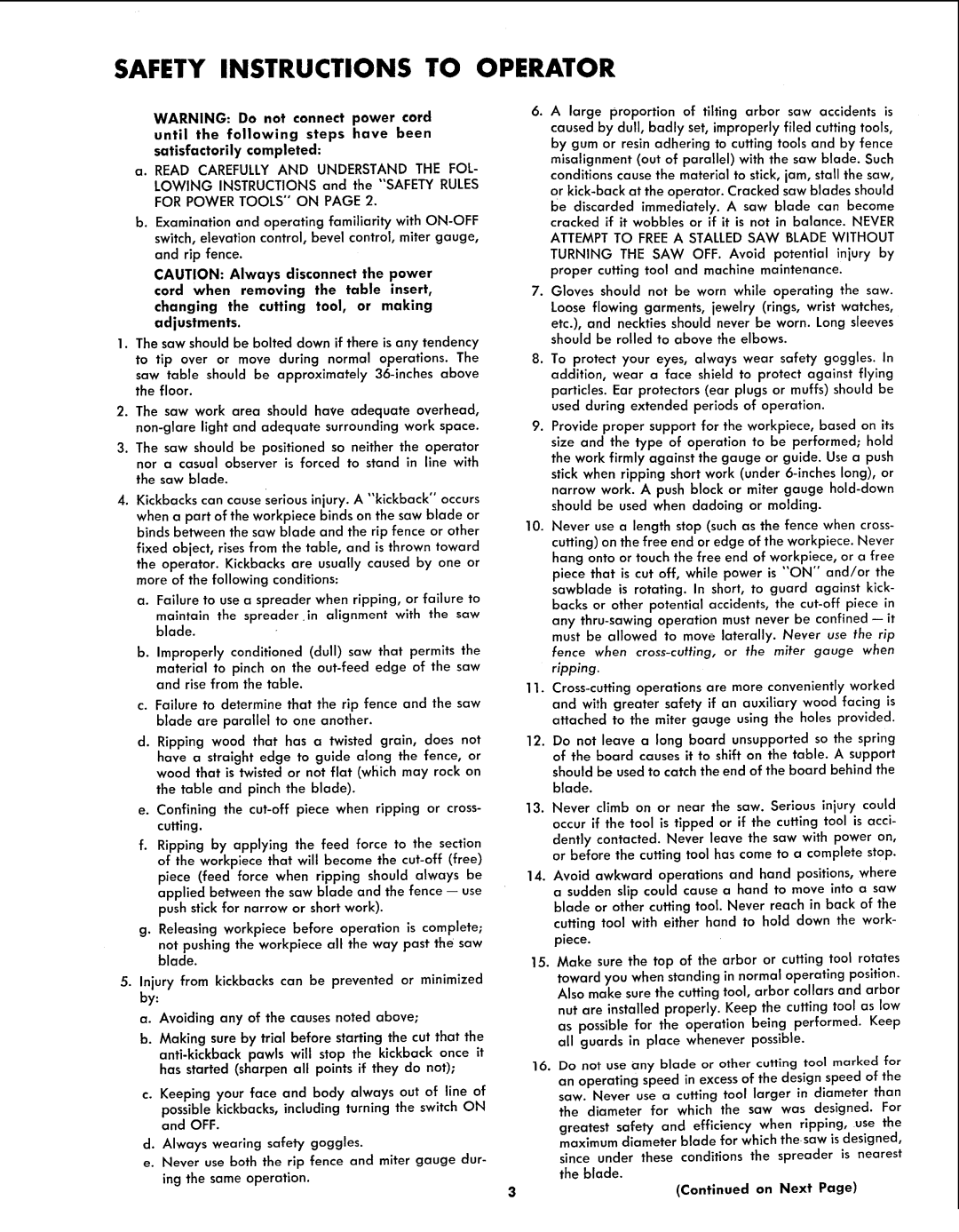
SAFETY INSTRUCTIONS TO OPERATOR
WARNING: Do not connect power cord
until the following steps have been satisfactorily completed:
a. READ CAREFULLY AND UNDERSTAND THE FOL- LOWING INSTRUCTIONS and the "SAFETY RULES FOR POWER TOOLS" ON PAGE 2.
b. Examination and operating familiarity with
CAUTION: Always disconnect the power cord when removing the table insert, changing the cutting tool, or making adjustments.
1.The saw should be bolted down if there is any tendency to tip over or move during normal operations. The saw table should be approximately
2.The saw work area should have adequate overhead,
3.The saw should be positioned so neither the operator nor a casual observer is forced to stand in line with the saw blade.
4.Kickbacks can cause Serious injury. A "kickback" occurs when a part of the workplece binds on the saw blade or binds between the saw blade and the rip fence or other fixed object, rises from the table, and is thrown toward the operator. Kickbacks are usually caused by one or more of the following conditions:
a.Failure to use a spreader when ripping, or failure to maintain the spreader.in alignment with the saw blade.
b.Improperly conditioned (dull) saw that permits the material to pinch on the
c.Failure to determine that the rip fence and the saw blade are parallel to one another.
d.Ripping wood that has a twisted grain, does not have a straight edge to guide along the fence, or wood that is twisted or not flat (which may rock on the table and pinch the blade).
e.Confining the
f. Ripping by applying the feed force to the section of the workplece that will become the
g. Releasing workplece before operation is complete; not pushing the workpiece all the way past the saw blade.
5.Injury from kickbacks can be prevented or minimized by:
a. Avoiding any of the causes noted above;
b.Making sure by trial before starting the cut that the
c.Keeping your face and body always out of line of possible kickbacks, including turning the switch ON and OFF.
d.Always wearing safety goggles.
e.Never use both the rip fence and miter gauge dur- ing the same operation.
6.A large proportion of tilting arbor saw accidents is caused by dull, badly set, improperly filed cutting tools, by gum or resin adhering to cutting tools and by fence misallgnment (out of parallel) with the saw blade. Such conditions cause the material to stick, jam, stall the saw, or
7.Gloves should not be worn while operating the saw. Loose flowing garments, jewelry (rings, wrist watches, etc.), and neckties should never be worn. Long sleeves should be rolled to above the elbows.
8.To protect your eyes, always wear safety goggles. In addition, wear a face shield to protect against flying particles. Ear protectors (ear plugs or muffs) should be used during extended periods of operation.
9.Provide proper support for the workpiece, based on its size and the type of operation to be performed; hold the work firmly against the gauge or guide. Use a push stick when ripping short work (under
10.Never use a length stop (such as the fence when cross- cutting) on the free end or edge of the workpiece. Never hang onto or touch the free end of workpiece, or a free piece that is cut off, while power is "ON" and/or the sawblade is rotating. In short, to guard against kick- backs or other potential accidents, the
11.
12.Do not leave a long board unsupported so the spring of the board causes it to shift on the table. A support should be used to catch the end of the board behind the blade.
13.Never climb on or near the saw. Serious injury could occur if the tool is tipped or if the cutting tool is acci-
dently contacted. Never leave the saw with power on, or before the cutting tool has come to a complete stop.
14.Avoid awkward operations and hand positions, where
a sudden slip could cause a hand to move into a saw blade or other cutting tool. Never reach in back of the cutting tool with either hand to hold down the work-
piece.
15.Make sure the top of the arbor or cutting tool rotates
toward you when standing in normal operating position. Also make sure the cutting tool, arbor collars and arbor
nut are installed properly. Keep the cutting tool as low as possible for the operation being performed. Keep all guards in place whenever possible.
16.Do not use any blade or other cutting tool marked for an operating speed in excess of the design speed of the saw. Never use a cutting tool larger in diameter than the diameter for which the saw was designed. For
greatest safety and efficiency when ripping, use the maximum diameter blade for which thesaw is designed,
since under these conditions the spreader is nearest the blade.
